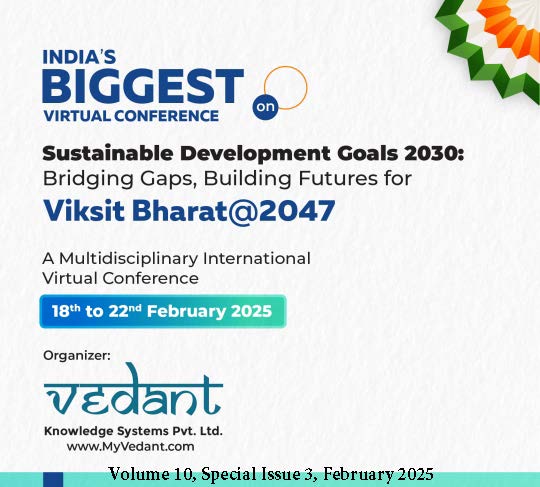Exploring Migration in Chhattisgarh: A Socio –Economic Inquiry
DOI:
https://doi.org/10.58213/vidhyayana.v10isi3.2221Keywords:
Chhattisgarh, Migration, Displacement, Inter-State migration, Intra-State Migration, Scheduled TribesAbstract
Migration is a pervasive and ongoing phenomenon in Chhattisgarh, driven by a combination of push factors that compel individuals to leave their localities in pursuit of better opportunities. Employment remains the primary reason for male out-migration, while marriage is the predominant driver of female migration. High poverty rates and socio-economic vulnerabilities among Scheduled Tribes (STs) further complicate the migration landscape in the state. Data from the Census 2011 D-series on migration reveal that the rate of male and female out-migration from Chhattisgarh for economic reasons, such as work and employment, is double the national average. This underscores the state’s economic dependence on migration. Migrants from poorer and less developed regions, like Chhattisgarh, often prefer industrialized and urbanized states as destinations, with Maharashtra emerging as the most popular choice for migrants from the state. While high rates of migration from poorer states can result in a loss of human capital needed for local development, migration also offers potential benefits, such as reducing unemployment and generating remittances. This dual impact highlights the need for a nuanced approach to migration policy. This paper also examines trends in reason-specific intra-state migration among the ST community, offering valuable insights for designing targeted policies. Migration in Chhattisgarh reflects and perpetuates socio-economic inequalities, necessitating a comprehensive approach to address its challenges A detailed understanding of these trends is essential for addressing economic disparities and promoting inclusive development. A holistic strategy is required, focusing on rural development, infrastructure enhancement, and policy reforms that support migrants at both their points of origin and their destinations.
Downloads
References
Andrienko, Yuri, Guriev, Sergei (2003). “Determinants of Interregional Mobility in Russia: Evidence from Panel Data”, Economics of Transition, Vol. 12, pp 1-2.
Barro, Robert J. and Xavier Sala-i-Martin (1991). Convergence Across States and Region, Brookings Papers on Economic Activity, no. 1, pp 107-182.
Bhagat, R. B. 2009. “Internal Migration in India: Are the Underclass More Mobile?” Paper presented in XXVI IUSSP General Population Conference, Marrakesh, Morocco.
Bhattacharya, P.C. (1998). The Informal sector and Rural-to-Urban Migration: Some Indian Evidence, Economic Political Weekly, May 23.
Census of India. 2011. Migration Tables. Office of the Registrar General of India, New Delhi.
Chandrasekhar, S., and Sharma, A. 2014. “Urbanisation and Spatial Patterns of Internal Migration in India.” IGIDR Working Paper No. 2014-016. Mumbai: Indira Gandhi Institute of Development Research.
Harris, J and Todaro (1970). “Migration, Unemployment and Development: A Two-Sector Analysis”, The American Economic Review Vol. 60, No. 1 (1970), pp. 126-142 (17 pages) American Economic Association
Kochar, A. 2004. “Urban Influences on Rural Schooling in India.” Journal of Development Economics 74(1): 113–136.
Kujur, R and Minz, S. K. 2021. “Proliferation of Tribal Migrants and Repercussion: Case Study from the Tribal Areas of Sundargarh District, Odisha (India).” Current Research Journal of Social Sciences and Humanities 4(1): 27-44.
Kumar, A and Deogharia, P. C. 2017. “Impact of MGNREGA on Rural –Urban Migration: A Case Study of Jharkhand.” Journal of Economics and Social Development 13(2): 96-113.
Kundu, A. 2007. Proceedings of Dr C. Chandrasekaran Memorial Lecture on Migration and Exclusionary Urban Growth in India. IIPS Newsletter 48(3&4): 5-23.
Lewis, A. (1954). “Economic Development with unlimited supplies of labour”, Manchester School of Economic and Social Studies, May.
Lucas, R. E. B. 1997. “Internal Migration in Developing Countries.” In Handbook of Population and Family Economics, Part -1, edited by M. Rosenzweig and O. Stark,
pp. 721–798. Amsterdam, New York, and Oxford: Elsevier Science, North-Holland.
Mitra, A. and M. Murayama (2008). “Rural to Urban Migration: A District Level Analysis for India”, IDE discussion paper no. 137.
Sarkar, P. 2014. “An Analysis of Inter-state Quantum Migration in India: An Empirical Validation of the ‘Push-Pull Framework’ and Gains from Migration.” Indian Journal of Labor Economics 57(3): 267–281.
Sarkar, P. 2019. “Associated Gains from Migration.” In Handbook of Internal Migration in India, edited by Rajan, I.S. and Sumeetha, M., pp. 273–286. India: Sage.
Parganiha, O.P.2002. “Impact of migration on livelihood system of the Farmer in Raipur District of Chhattisgarh,” M.Sc. (Ag) Thesis submitted to Department of Agriculture Extension IGKV, Raipur (C.G.).
